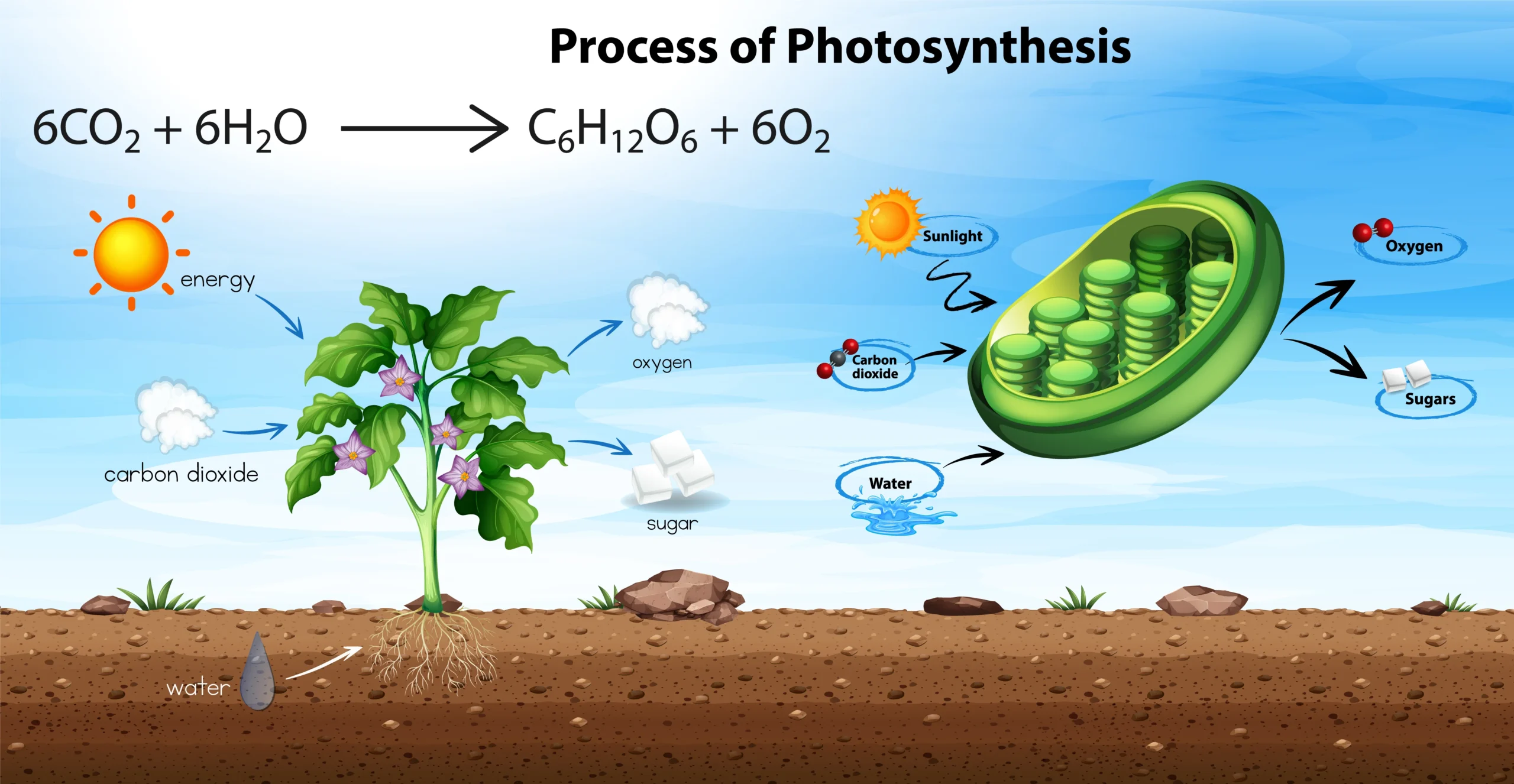Introduction
Photosynthesis is a vital biological process that sustains life on Earth. It is the mechanism by which green plants, algae, and some bacteria convert light energy into chemical energy, producing oxygen and glucose as byproducts. This process not only forms the foundation of the food chain but also regulates the planet’s atmosphere. Understanding how photosynthesis occurs can provide insight into the remarkable efficiency of nature’s energy conversion methods. In this article, we will explore the stages of photosynthesis, the role of different components, and the importance of this process for life on Earth.
What is Photosynthesis?
Photosynthesis is a biochemical process by which plants, algae, and certain bacteria transform light energy into chemical energy. This energy is stored in glucose, a type of sugar, which serves as a primary source of energy for these organisms and others in the ecosystem.
The Basic Equation of Photosynthesis
The general equation for photosynthesis can be represented as:
[
6CO_2 + 6H_2O + \text{light energy} \rightarrow C_6H_{12}O_6 + 6O_2
]
This equation indicates that carbon dioxide (CO₂) and water (H₂O), in the presence of light energy, are converted into glucose (C₆H₁₂O₆) and oxygen (O₂).
The Two Main Stages of Photosynthesis
Photosynthesis occurs in two main stages: the light-dependent reactions and the Calvin cycle, also known as the light-independent reactions. Each stage plays a crucial role in converting light energy into chemical energy.
1. Light-Dependent Reactions
Light-dependent reactions occur in the thylakoid membranes of the chloroplasts. These reactions require sunlight to produce energy-rich molecules like ATP (adenosine triphosphate) and NADPH (nicotinamide adenine dinucleotide phosphate), which are used in the second stage of photosynthesis.
How Light-Dependent Reactions Work
- Absorption of Light: Chlorophyll, the green pigment in the chloroplasts, absorbs light energy, primarily from the blue and red wavelengths of the spectrum. This energy excites electrons in the chlorophyll molecules.
- Electron Transport Chain (ETC): The excited electrons are transferred to an electron transport chain, a series of proteins embedded in the thylakoid membrane. As electrons move through the chain, they release energy that is used to pump protons into the thylakoid space, creating a proton gradient.
- ATP Synthesis: The proton gradient created by the ETC drives the synthesis of ATP from ADP (adenosine diphosphate) and inorganic phosphate (Pi) through a process called chemiosmosis, facilitated by the enzyme ATP synthase.
- Production of NADPH: At the end of the electron transport chain, electrons combine with NADP⁺ (nicotinamide adenine dinucleotide phosphate) to form NADPH, a molecule that carries energy-rich electrons to the Calvin cycle.
2. Calvin Cycle (Light-Independent Reactions)
The Calvin cycle occurs in the stroma of the chloroplast, where the energy from ATP and NADPH produced in the light-dependent reactions is used to convert carbon dioxide into glucose.
Steps of the Calvin Cycle
- Carbon Fixation: Carbon dioxide molecules are attached to a five-carbon sugar called ribulose bisphosphate (RuBP). This reaction is catalyzed by the enzyme ribulose-1,5-bisphosphate carboxylase/oxygenase, commonly known as RuBisCO. The product is a six-carbon compound that immediately splits into two molecules of 3-phosphoglycerate (3-PGA).
- Reduction Phase: The 3-PGA molecules are converted into glyceraldehyde-3-phosphate (G3P) using energy from ATP and electrons from NADPH. G3P is a three-carbon sugar that can be used to form glucose and other carbohydrates.
- Regeneration of RuBP: Some of the G3P molecules are used to regenerate RuBP, allowing the cycle to continue. This regeneration process requires additional ATP.
- Glucose Formation: For every six molecules of carbon dioxide fixed, two molecules of G3P are produced, which are then combined to form one molecule of glucose.
The Role of Chloroplasts in Photosynthesis
Chloroplasts are specialized organelles found in plant cells and are the primary sites where photosynthesis occurs. Understanding the structure of chloroplasts is essential to grasp how photosynthesis functions.
Key Components of Chloroplasts
- Thylakoid Membranes: These are disc-shaped structures stacked into grana, where light-dependent reactions occur. They contain chlorophyll and other pigments that capture light energy.
- Stroma: The fluid-filled space surrounding the thylakoids is where the Calvin cycle takes place. It contains enzymes that facilitate the conversion of carbon dioxide into glucose.
- Chlorophyll and Pigments: Chlorophyll absorbs light most efficiently in the blue and red wavelengths, reflecting green light, which is why plants appear green. Other pigments, like carotenoids, help in capturing additional light energy and protect the chlorophyll from damage by excess light.
Factors Affecting Photosynthesis
Photosynthesis efficiency can be influenced by several environmental factors:
Light Intensity
- Higher light intensity generally increases the rate of photosynthesis up to a point, after which the rate plateaus because the photosynthetic machinery becomes saturated.
Carbon Dioxide Concentration
- Elevated levels of carbon dioxide can enhance the photosynthesis rate, especially under conditions where light is not a limiting factor.
Temperature
- Photosynthesis is temperature-dependent. Too low or too high temperatures can decrease the rate of photosynthesis by affecting enzyme activity, particularly RuBisCO.
Water Availability
- Water is a critical reactant in photosynthesis. A lack of water can cause stomata (small openings on the leaf surface) to close, reducing carbon dioxide intake and thus slowing down photosynthesis.
The Importance of Photosynthesis to Life on Earth
Photosynthesis is essential for sustaining life on Earth in several ways:
Oxygen Production
- Photosynthesis is the primary source of atmospheric oxygen. It releases oxygen as a byproduct, which is vital for the survival of aerobic organisms, including humans.
Foundation of Food Chains
- Plants and other photosynthetic organisms are the base of most food chains. They produce organic matter (glucose) that is consumed by herbivores, which are then consumed by carnivores, creating an interconnected web of life.
Carbon Dioxide Regulation
- Photosynthesis helps regulate atmospheric carbon dioxide levels, mitigating the effects of global warming and maintaining the Earth’s climate balance.
Conclusion
Photosynthesis is a complex yet fascinating process that enables green plants, algae, and some bacteria to convert light energy into chemical energy, sustaining life on Earth. Through the light-dependent reactions and the Calvin cycle, photosynthesis transforms carbon dioxide and water into glucose and oxygen, which are essential for all aerobic life forms. Understanding how photosynthesis occurs provides insight into the intricate balance of our ecosystem and highlights the vital role that plants play in maintaining a livable planet. As we continue to study and learn from photosynthesis, we can better appreciate the beauty and efficiency of nature’s energy conversion processes.


